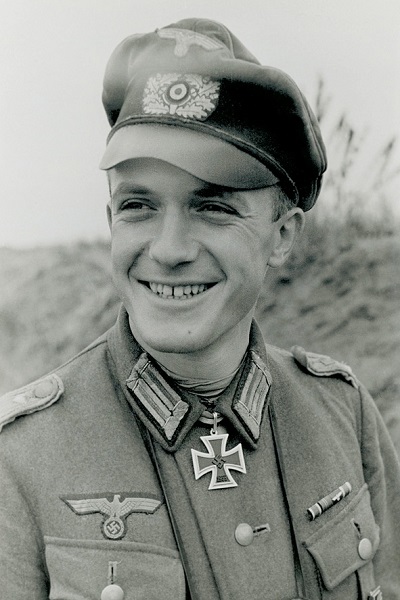Feldmann, Alfred
- Date of birth:
- February 20th, 1915 (Burscheid-Sträßchen/Rhineprovince, Germany)
- Date of death:
- January 14th, 1943 (Savkino, Soviet Union)
- Nationality:
- German
Biography
Do you have more information about this person? Inform us!
- Period:
- Second World War (1939-1945)
- Rank:
- Hauptmann (Captain)
- Unit:
- Führer, I. Bataillon, Infanterie-Regiment 454, 254. Infanterie-Division, Heer
- Awarded on:
- August 20th, 1942
“After long and costly attacks into the Volkhov pocket, after weeks-long marching and fighting through thick forests and trackless swamps, after the storming of countless bunkers and field positions, after the capture of a number of important forest swathes the Russians were using to supply their forces, and after the breaking of all enemy resistance at great cost in physical effort, at around 18:00 on the 26.06.1942 Feldmann’s Bataillon reached the edge of forest along the Kerestj river (northeast of Kretschno). By then reduced to 121 men, it was the first Bataillon of the Division to reach this location. The soldiers were at the end of their strength. They had had insufficient quantities of food for a while and had received no warm meals for many days. Ammunition resupply via horse columns encountered almost insurmountable difficulties. The Bataillon was almost burned out.
A crossing of the Kerestj river (8 metres wide and about 1.5 metres deep) appeared to be a nigh impossible task with such exhausted soldiers. The small railroad bridge over the river had been destroyed by the Russians following the appearance of the Bataillon at the forest edge. Under these circumstances the Regiment decided to disregard the order to form a bridgehead. Such a move would be especially foolhardy as a completely open area of ground about 70 metres deep lay between the forest edge and the river. Similarly, another treeless meadow over 100 metres wide was to be found on the other side of the river. At the edge of this the Russians had dug into the forest and its undergrowth with numerous heavy and light infantry weapons, and kept a constant watch over the open spaces adjacent to the river.
However Hauptmann Feldmann saw how the Russians were being constantly reinforced on the other side. Anti-tank guns and artillery were being brought into position and dug-in. These additional forces would likely ensure the failure of any assault on the following day, or at least result in intolerably high losses for the whole Division. He thus made the independent decision to order an attack and the formation of a bridgehead immediately. He would dispense with any artillery support so as to avoid any further delay.
At 20:10 on the 22.06.1942 Hauptmann Feldmann gave the signal to attack. As his own Bataillon proceeded slowly and hesitantly out of the protection of the woods, Hauptmann Feldmann stormed forwards with 2. Kompanie, specifically the point Zug. He was the first man of the Bataillon to cross the river (which was chest deep) and inspired his men to do the same. After 2. Kompanie and then the whole Bataillon had crossed the river, an assault was launched over the open fields and a bridgehead was formed on the opposite bank as far as the forest edge. The enemy were so surprised by this attempt that they were unable to bring their heavy weapons to bear effectively despite their superior numbers of men and weapons. The result was that the Bataillon was spared heavy losses.
On the same evening all the remaining units of the Infanterie-Regiment 454 crossed over in the wake of its I. Bataillon. In the early morning hours of the 23.06.1942 the remaining elements of the 254. Infanterie-Division crossed over into the bridgehead along with parts of Kampfgruppe Gurran (61. Infanterie-Division). As such it was Hauptmann Feldmann’s independent action and outstanding personal bravery that created the foundation for the continued advance of the entire 254. Infanterie-Division along the Russian field railway as well as the Friedrich and Erika forest areas. It was along this axis that most of the captured equipment and prisoners mentioned in the Wehrmachtbericht were taken. It was also the route along which the Volkhov pocket would be pierced through, an advance which ended in the establishment of contact with Gruppe Wandel after a few days.”
- Period:
- Second World War (1939-1945)
- Period:
- Second World War (1939-1945)





